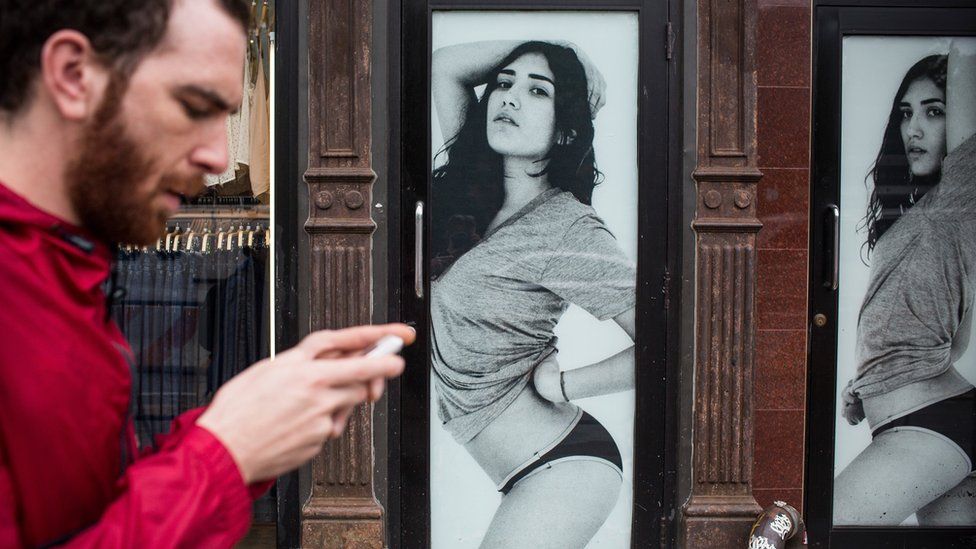Will bankruptcy cost American Apparel its cool?
- Published

Normally making news over its raunchy advertising or its beleaguered founder, American Apparel's problems are now decidedly less risque.
The controversial fashion line filed for bankruptcy with the US courts on Monday, struggling to keep its cool persona while juggling lawsuits and mounting debt.
Until now, much of the company's woes have centred on founder Dov Charney.
Mr Charney founded the company while he was a student at Tufts University in 1989. The sexually provocative advertising campaigns, skintight clothing, and retro designs helped make the company popular among young people.
Business choices like manufacturing in the US have set the company further apart from other retail brands.
In December 2014 Mr Charney was fired from the helm amid mounting sexual harassment lawsuits and slumping share prices. He has filed a wrongful termination suit against the company.
In the end though it wasn't the sexually explicit emails its founder sent to employees or any failure by the new CEO Paula Schneider, but more basic issues faced by retailers - getting too big, too fast and taking on too much debt.
American Apparel has built up its reputation as a brand by defying many social norms.
"When you see a company doing what no else does, you think that is notable. But on the other hand you wonder whether if there was a reason no else was doing it," said Kevin Starke a research analyst at CRT Capital Group.
Its models are typically shown half-dressed and in provocative positions. Many of the models are not professionals but are presented along with their bios in the ads. The company has featured orthodox Jews, a 62-year-old and models of every race.
This cultural diversity that the Los Angeles-based company has championed the brand to appeal outside the US, while still maintaining an American feel.
The company has faced its share of controversy in the UK as well. Several ads were banned by the Advertising Standards Authority (ASA) after complaints in 2009 and 2012. Another round of ads, which featured a model wearing a thong bathing suit, was banned in March.
American Apparel has 260 stores across 19 countries including 18 stores in the UK. Many of the new locations have been opened in recent years capitalising on the brand's growing popularity.
The company's bankruptcy proposal includes plans to end a number of multi-year leases on store front property. Without filing for bankruptcy, it would be difficult for the company to get out of these agreements.
It is unclear if the UK stores will be affected by this scheme.
American Apparel is not the only company in this market facing issues of scale.
Another US retail chain, Abercrombie and Fitch, popular with teens, has released plans to close stores after expanding too quickly. Abercrombie became known for building its cool factor by creating stores that mimicked nightclubs more than clothing shops.
The company will also have to rethink its inventory strategy within each remaining store. Most keep a large amount of basic inventory on hand including T-shirts and leggings but too much in stock can be costly for a company.
American Apparel makes 75% of its sales from 600 basic items and figuring out a better inventory ratio will be tough.
The company's manufacturing has created a Catch-22 for the brand as well. Customers are attracted to the made in America approach, but this raises the price of each garment.
American Apparel has given no indication it will change this approach and any restructuring plan that keeps the company open will probably need to capitalise on this unique platform.
The retail approach of the company though will probably be in for a change, as it attempts to drive more sales through its website.
Most clothing retailers make about 20% of their sales online. In comparison 11% of American Apparel's sales are online.
"The company has been in dire need of adult supervision," said Craig Johnson, president of consulting firm Customer Growth Partners. "The company has good assets and it has a good brand name, but its corporate governance is a mess."
The new CEO Paula Schneider will have to slim down the business. In an interview with Forbes Magazine in January she said her first plan was to formalise internal processes that had been more chaotic under Mr Charney.
While she has roots in retail, having run the swimwear department at Warnaco and other retail brands for the private equity firm The Gores Group, the real question will be whether she can reorganise the company while retaining the cool factor.
- Published20 June 2014
- Published4 April 2012